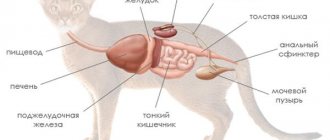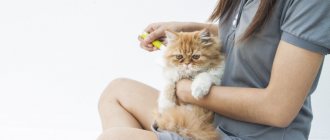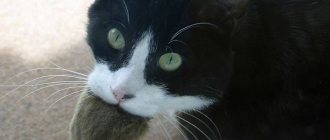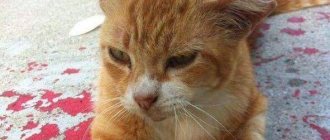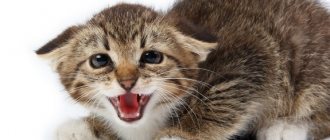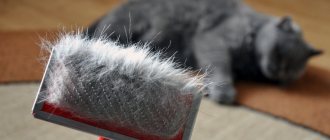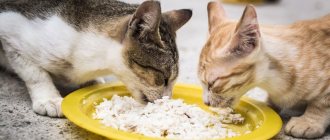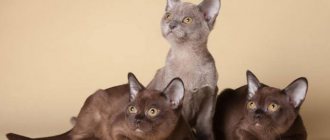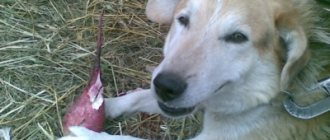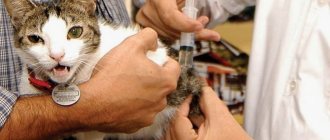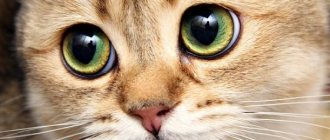What is blood type?
Blood group is what allows individuals (both humans and animals) to be grouped into certain biological groups. These are immunogenetic characteristics that determine the hereditary combination of cells - red blood cells. It does not change during the life of a person or animal. Therefore, to the question: “Do cats and dogs have a blood type?” you can confidently answer “Yes, there is.”
Group characteristics are formed in the prenatal period. This occurs under the influence of allelic genes that are responsible for the characteristics of antigens in red blood cells.
What does cross-sampling mean?
Unlike blood typing, which looks for antigens on the membranes of red blood cells, a crossover test only evaluates the presence of antibodies in the plasma. There are main (large) and auxiliary (small) cross-tests, as well as control of the recipient’s own blood.
- Main: recipient plasma + donor erythrocytes – the most clinically significant; antibodies to donor erythrocytes are detected in the recipient’s plasma;
- Auxiliary: donor plasma + recipient erythrocytes – antibodies to the recipient’s erythrocytes are detected;
- ·Control: recipient plasma + recipient erythrocytes – antibodies to the recipient’s own erythrocytes.
A cross-sample does not provide a 100% guarantee that the recipient will reject the donor's blood.
How to determine the blood type of animals?
Blood group determination in cats and other animals is carried out using special reagents. Specific sera are used that contain one labeled antibody for each specific antigen.
The determination procedure itself involves mixing blood with serum. When agglutination with serum does not occur, this will mean that the material belongs precisely to the group for which antibodies were contained in the serum.
Various reactions are used to determine blood type in different animals. For example, in birds and pigs the agglutination reaction is taken as a basis, but to determine the group in cattle, the reaction of conglutination and hemolysis is assessed.
Blood incompatibility during transfusion
Unfortunately, any animal may require an emergency transfusion due to injury or illness. Before starting the procedure, the doctor will definitely conduct the necessary tests. But if you know your pet’s blood type, this will help you find a donor faster.
Hemotransfusion (blood transfusion) may be urgently needed in the following cases:
- serious injury with large loss of blood;
- prolonged, although not severe, bleeding;
- difficult childbirth;
- extensive surgery.
The procedure is also indicated for anemia, decreased immune status, blood clotting disorders, as well as chronic inflammatory processes and very severe poisoning.
Important! In the event of a blood transfusion of an incompatible group, antibodies will attack foreign cells of the donor blood, which in most cases leads to death.
The meaning of blood group for animals
Blood groups in dogs and cats, and especially in farm animals, are of great importance in their breeding. One type of animal can have hundreds of different variants.
Assigning an animal to one group or another is important for blood transfusion or organ and tissue transplantation. In the practice of animal breeding, genetic blood traits are used to trace the ancestry and pedigree, as well as the genetic structures of entire groups of animals. Taking into account group characteristics makes it possible to breed animals with improved performance.
How many blood types do animals have?
We have figured out the presence of the latter in animals. Now the question may arise: “How many blood types do cats and other animals have?”
For example, 12 blood groups have been identified in cattle, 15 in pigs, 14 in chickens, and 7 in horses and sheep. As for our pets, 8 groups have been found in dogs, and 3 in cats.
Such a large number of groups in animals is explained by the fact that their blood contains a large number of antigens that have not yet been fully studied. As a result, new groups arise among one species of animal.
Interesting fact! The blood of animals and humans is absolutely not suitable for transfusions to each other. Even a chimpanzee or ape that seems so close to us is also not suitable. And all this despite the fact that the first experience of blood transfusion was from sheep to humans, even before the discovery of the latter’s blood groups. By the way, it ended successfully.
Fading Kitten Syndrome , have begun to appear more and more often . The reason for this is the mating of a cat and a cat with different blood groups. The kittens were born absolutely healthy, but died within 24 hours. To avoid such cases, cat owners should know about the basic principles of inheritance of blood groups and, most importantly, understand how to act in these cases in order to save their babies.
In connection with the above, a new concept has emerged: Feline Neonatal Isoerythrolysis - hemolysis of newborn kittens. What is this? This is not a disease, since you cannot treat newborn kittens with medication. But this is terrible, especially if this happens to your kittens.
Feline Neonatal Isoerythrolysis is the destruction of red blood cells (erythrocytes) with the release of hemoglobin into the blood plasma, which ends in the death of kittens.
Humans also have several blood types.
Human blood groups : AO - 42%, BO - 14%, AB - 7%, OO - 37%.
And there is the “ Rh factor ” (Rh). Women with (Rh-) may experience complications during pregnancy, and the baby may experience complications after birth.
For example: Mother with (Rh-) and father with (Rh+)
If in the womb a child has (Rh+) blood and, during pregnancy or childbirth, part of the child's positive blood (Rh+) enters the bloodstream of the mother's (Rh-) blood, then the mother's body recognizes (Rh+) as foreign and forms antibodies against it. During the next pregnancy with a child with (Rh+), the mother’s body may reject the fetus and a miscarriage will occur. But there is, of course, an exception to the rule. If the mother has (Rh+) and the father (Rh-), then pregnancy occurs without problems.
Let's get back to cats.
Until 1981, the issue of cat blood groups remained unaddressed. Only Auer and Bell conducted experiments and proved the importance of this problem when transfusing the blood of sick cats and in preventing the death of newborn kittens.
The transmission of blood types in cats follows Mendel's laws.
Today cats have three blood types:
A- has pairs of genes: A/A or A/B, where A is the dominant gene and suppresses the properties of B. AB is very rare and has not yet been fully studied. AB is a completely different blood type than A/B.
Blood type B – formed through B/B genes.
Dependence of blood type on cat breed.
It has been proven that blood groups depend on the breed and location of the cat. Most of the cats “from the street” have group A. In the Siamese and related breeds (Burmese, Ocicat, Oriental) A. From 1 to 5% of Maine Coons and Norwegian forest cats have group B. Group B in Abyssinians, Somalis, Scottish Fold, Burmese, Kuril Bobtail and Persians account for 5-25%, for British Shorthairs, Exotic Shorthairs and Rexes it is 30-60%. Group AB is extremely rare.
What are the consequences of blood type incompatibility?
Incompatibility leads to tragic consequences when:
1. Destruction of the newborn’s red blood cells and his death due to incompatibility of the blood of the mother cat and the kitten.
2. During blood transfusion.
A kitten's life is at risk when the mother cat has blood type B, the father cat has type A blood, and the kitten has type A or AB blood (i.e., identical to the father's blood group) (see table). For this kitten, when it is in the womb, there is no danger, since maternal blood antibodies practically do not penetrate through the placenta, destroying the red blood cells of the fetus. Moreover, the birth goes well and the kittens are born absolutely healthy, but within 24 hours the babies suddenly die asymptomatically.
How can you determine?
· Refusal of mother's milk,
· Kittens become very weak
· Their urine turns red-brown in color - this is due to the entry of destroyed red blood cells, then death occurs.
Attention! Kittens can live, developing normally, for two weeks, but at the age of one to two weeks the tip of their tail dies off.
The reason for all this is that the mother’s antibodies, which are dangerous for kittens, enter their blood. Antibodies are found in cat milk. They are absorbed through the intestinal walls of newborns and enter the blood. Agglutination (destruction) of red blood cells occurs. The kitten's red blood cells decrease and anemia occurs. Protein gets into the urine and damages the kidneys. As a result, metabolism is completely disrupted. The kitten is dying. Less often, the kitten overcomes the critical period, as a result the tip of the tail dies. This is due to the fact that the tail is located farthest from the heart and blood passes there through the thinnest capillaries. Blood circulation is disrupted only there, and the tip of the tail, not receiving blood, dies.
There are cases when some of the kittens from the litter remain healthy, this is due to the fact that the intestinal walls of these kittens are thicker and do not allow the mother’s antibodies to pass through. It happens even less often that kittens with incompatible blood groups remain alive, but this is the case if the concentration of antibodies in the mother’s milk is low.
What to do?
The ideal option is to know the blood types of the animals being crossed. But it is difficult to do a kitten blood test in our country.
If, based on the above signs, you have determined that the kitten is at risk, then you need to find another nurse cat with blood type A for the kitten for 3-4 days, or keep the kitten on artificial nutrition (there is a special cat’s milk substitute). Then on the fourth day the kitten's intestinal walls thicken and he can be returned to his mother for feeding.
What to do if you don’t know your mother cat’s blood type?
· You can immediately take kittens away for several days
· Determine the color of urine - give the kitten a drink of mother's milk at birth and massage the tummy, collecting urine with a cotton swab. If the stick remains white and the urine is clear, then everything is fine, but if the stick turns bloody or brown or light brown, then you need to act according to the above scenario
Is it possible to breed cats with blood type B?
Cats and cats with blood group B are not a disadvantage of a purebred cat. It is a feature, like eye color or coloring. They require a more attentive attitude towards themselves and careful selection of partners.
Attention! Cats with blood type B are ideal partners for any cat, as is a cat with blood type A. Cats with blood type A can be safely mated with cats of the same type.
How blood groups are inherited CAT + CAT = KITTENS
| CAT | CAT | KITTENS |
| A=A/A | A=A/A | A=A/A |
| A=A/A | A=A/B | A=A/A or A=A/B |
| A=A/A | V=V/V | A=A/B |
| A=A/B | A=A/A | A=A/B or A=A/A |
| A=A/B | A=A/B | A=A/A or A=A/B and B=B/B |
| A=A/B | V=V/V | A=A/B or B=B/B |
| V=V/V | A=A/A | A=A/B** |
| V=V/V | A=A/B | A=A/B** or B=B/B |
| V=V/V | V=V/V | V=V/V |
Only kittens marked with ** will show the sign of incompatibility.
So what needs to be done to prevent incompatibility?
1. Only knit type B with type B.
2. Avoid the following blood combination: CAT + CAT = KITTENS
| B=B/B | A=A/A | A=A/B |
| B=B/B | A=A/B | A=A/B or B=B/B |
"Cat" blood types
Cats, just like people, have 2 antigens: A and B. If humans have 4, then cats have only 3: A, B, AB. Moreover, group AB is the rarest, and group 0 does not exist at all, at least for now.
Considering the above, you need to keep in mind that only cats and female cats need blood transfusions of their groups. This is a significant difference between them and other pets, such as dogs. For them, this process does not require such control and takes place with virtually no risk to life and health.
The other two groups (A and B) are common, with group A being the most numerous.
Research on blood groups in cats began not so long ago as the study of a similar issue in humans. Only in 1953 were they bred by an English scientist, who also studied the patterns of their inheritance.
After this discovery there was a thirty-year break. No one studied this issue, because it began to be considered not so important in veterinary medicine. After we were faced with the sudden death of newborn kittens and hemolysis of their blood (as it turned out later), interest in this issue increased again.
Only in 1981, scientists Auer and Bell experimentally proved the fundamental nature of this issue in blood transfusion of sick animals and the prevention of mortality in newborn kittens.
Since cats do not have the Rh factor, the inheritance of blood types occurs according to the laws of Mendel, who is well known to everyone since school for his experiments in crossing peas.
You can now find out what blood type a cat has in a veterinary or diagnostic laboratory that specializes in this.
Why is it important
In the 50s, English scientists examined the blood of cats and determined the presence of groups and patterns of inheritance. But then, for 30 years, practically no one dealt with this issue; they did not consider it important. And only in the early 80s did zoologists return to research.
Blood is red in color due to blood cells called erythrocytes. In addition to the fact that these blood elements carry oxygen to every cell of the body, they are also responsible for the blood type. The red blood cell carries a protein called an antigen, and the blood plasma contains antibody proteins. They are responsible for the destruction of foreign antigens.
Knowing exactly which group your pet belongs to is important in the following cases:
- if the animal requires a blood transfusion;
- when choosing a partner for breeding.
Veterinarians strongly recommend testing to determine your blood type at an early age. This will save valuable time if your pet suddenly needs emergency medical care.
Breeds and blood types
Through their research, scientists from America and England have proven that the inheritance of certain blood types in cats is influenced by the breed and area where the animal lives.
Group A. Most cats without a breed have it. As for purebred cats, this group is observed in Siamese and Oriental cats, as well as in breeds close to them such as Burmese, Ocicat, etc.
Group B. This group is less common, for example, only 5% of the Maine Coon and Norwegian Forest breeds. But among Abyssinians, Somalia, Scottish Fold, Burmese, Kuril Bobtail and Persian cats, this group is found in 20-25% of animals. The most numerous breeds with this blood type are British cats, exotic shorthairs and rex cats. 30-60% of their representatives have it.
Group AB. It is very rare, so there are no statistical data on this blood type in cats. Breeders try not to mix blood of groups A and B to eliminate the mortality of offspring and preserve the purity of the animal’s pedigree.
Frequency of occurrence of different blood groups in the cat population
In domestic mongrel cats, the frequency of occurrence of different blood groups varies in different countries. In the USA, almost all outbred cats have blood type A (99.7%), in Australia - 73%. The remaining part is almost entirely represented by blood group B; AB is extremely rare (less than 1%). In purebred cats, the geographical factor has virtually no effect on the prevalence of blood groups. In some breeds, especially Orientals, blood type B is extremely rare. It has been found that in the Burmese sacred cat, if the choice of father and mother is made by chance, the risk of hemolytic disease of the newborn is 21%! Theoretically, every fifth offspring is susceptible to this disease. Frequency of occurrence of blood type B in different breeds of cats that took part in the study
| Breed | Frequency of occurrence of group B (genotype B/B) | |
| Siamese, Tonkinese, Russian Blue, Ocicat, Bengal, Bombay | Very rarely | |
| Maine Coon, Norwegian Forest, Burmese | 1-10% | |
| Persian, Scottish fold, Somali | 11-20% | |
| Burmese sacred, ragdoll | 20-40% | |
| British Shorthair, Cornish Rex and Devon Rex, Turkish Van | 40-60% |
This is interesting: How to make friends between a cat and a kitten?
Blood transfusion
As we have already found out, each animal has specific blood, so its transfusion between different types of animals can be destructive.
If a person has about 5 liters of blood in the body, then cats have about 70 ml per kilogram of weight. Thus, a 3-kilogram cat will have approximately 210 ml of this red liquid, but a large cat weighing 6-7 kilograms will have about half a liter (420-490 ml).
Blood transfusion may be required under various circumstances. Basically, if all the points are followed correctly, then this procedure is very successful in preserving the life and health of the pet. However, it is worth keeping in mind the risk of transmission of infection.
If the blood used is not fresh, that is, not the one that has already disappeared, but the one that has been cooled and stored, then problems in the cat’s immune system are possible. You may experience a slight fever or nausea during the transfusion or after the procedure.
An acute hemolytic reaction is possible, which can be fatal. The presence of any reaction should be reported to a veterinarian. It is also necessary to inform him if the cat has had a transfusion in the past.
Recommendations for cat breeders
The compatibility of blood groups in cats is important for their life and health. If incompatibility is observed, then disastrous consequences are possible, which most often lead to the death of the animal. It can appear in two cases: at birth or during a transfusion.
Incompatibility between the blood of a cat and her kitten develops according to the type of Rh conflict in humans. When a cat has group B, and a male cat has group A, and the kitten inherits the father’s group, that is, A, or has group AB, then a conflict develops. In the womb, the kittens are not in danger; they can be born healthy and without complications. But after a while you may notice the following:
- sudden death of a seemingly absolutely healthy kitten;
- poor appetite, dark urine, lethargy for the first three days, then death;
- the kittens look absolutely healthy, feed well on mother's milk and develop, but after 1-2 weeks the tip of their tail dies off.
All this happens because with mother's milk they consume mother's antibodies, which are harmful to their blood. In this case, in humans, it is recommended to stop breastfeeding and switch to artificial feeding. In veterinary medicine, this can also be applied, but the problem is that in animals it cannot be determined in advance and the necessary measures taken immediately after the birth of a kitten.
Of course, there are times when incompatible kittens survive and remain healthy. But for this, the kitten must have such individual characteristics that will prevent the absorption of maternal antibodies by the intestinal walls.
There is another option to save the litter. Immediately after birth, separate all kittens from their mother for 2-3 days, so that the permeability of the intestinal walls decreases enough to prevent maternal antibodies from leaking into the kitten’s blood. The cat can then safely feed her kittens on her own. But this method can significantly deteriorate the health of the litter.
In addition to the above symptoms of incompatibility, the following options are also possible:
- death of a kitten without visible symptoms of underdevelopment or disease;
- the newborn kitten is very weak and is not able to suck mother’s milk on its own;
- the kitten sucks milk on its own, but less and less each time;
- jaundice in a kitten (yellowishness of the mucous membranes);
- anemia due to blood hemolysis (destruction of red blood cells with further release of hemoglobin into the blood plasma);
- further growth and development while maintaining minimal occurrences of anemia.
We suggest you familiarize yourself with: Pickled ginger for weight loss: is it beneficial or harmful, is it possible to eat it while on a diet, and how to take it?
In order to avoid unpleasant consequences, there are several ways to prevent incompatibility between the group characteristics of a cat and a kitten.
- Prevention is better than eliminating consequences. For this purpose, only cats and cats with group B occur. In such a situation, antibodies to the blood of the fetus do not arise.
- Incompatibility only occurs in the case of blood group combinations such as cat B cat A = AB kittens or cat B cat AB = AB/B kittens. We must try to avoid such confusion.
- Take measures to save the litter if cat B and cat A were mated. Separate the kittens from their mother immediately after birth for at least a day, and preferably two or three. At this time, feed them yourself every 2 hours.
Blood group is a description of the individual antigenic characteristics of red blood cells, determined using methods for identifying specific groups of carbohydrates and proteins included in the membranes of animal red blood cells. (wikipedia)
Blood group is a sign determined by the individual antigenic characteristics of erythrocytes - red blood cells.
Several antigen systems have been discovered in cats, the main ones are described in this article. Today there are three known blood groups in cats:
- Blood group A, which is formed through the following pair of genes: A/A or A/B, where A is the dominant gene and suppresses the properties of B
- Blood type AB – formed through A/B genes
- Blood type B – formed through B/B genes.
Table 1 Cat blood groups.
Each blood group is characterized by the presence of certain proteins called antigens on the surface of red blood cells; these antigens designate a iv
https://www.youtube.com/watch?v=ytcopyrightru
If red blood cells on their surface contain:
- Only A antigens, then the cat’s blood group is A;
- Only B antigens, then the cat's blood group is B;
- Both antigens - a and b, then the cat's blood group is AB.
Table 2 Genetic nomenclature is used to designate blood groups.
Blood type A is always dominant to blood type B. The genetic test identifies blood type B cats, which have two copies of the b allele, and carrier cats, which have only one copy of the b allele. An animal may have blood type A or AB. Because the genetic test does not separate alleles A and a, then to formulate an answer it is customary to use the symbol “non-B” allele (Non-B or simply “N”)
*Allelic genes are different forms of the same gene located in the same areas. An organism whose allelic genes are identical is called homozygous (for a given trait). If the allelic genes are different - heterozygous.
When inheriting blood groups, the gene for group A is dominant over AB, the gene for group AB is dominant over B, a cat with blood group B has a homozygous pair B/B in this part of the gene, while a cat with blood type AB in this locus may have a heterozygous pair AB/ AB, or AB/B. Cats with blood type A have even more options: A/A, A/AB and A/B.
Table 3 You will receive this answer from the laboratory.
For example, consider the study's response to my cat's blood type.
St. Petersburg, molecular genetic laboratory "Zoogen"
The result of molecular genetic research for order 1000004869 is ready
ANIMAL NAME: AUDREY TIN ARDEN
Test name: Blood group A, blood group B, carriage of blood group B (cytidine monophospho-N-acetylneuraminic acid hydroxylase)
Genotype: A/B - heterozygote - blood group A, carrier of blood group B
This is the answer you will get in Russia.
We have already considered the options for mating cats with cats A B, A A/B and A/B A/B. The result of such matings is possible the birth of kittens with blood groups A, A/B and B.
Material for blood group testing: dried blood.
Most breeders are present at the birth of their cats. The moment we take a newly born kitten to wipe it and cut off the umbilical cord, the smallest drop of blood appears from the umbilical cord. It is necessary to soak a small piece of a clean napkin with this bloody drop and let it dry at room temperature.
Such testing of the blood type of kittens is necessary if the parents had blood type A/B - A/B, A/B - B/B.
Fig.1 A drop of blood on a napkin. Fig. 2 Buccal epithelium.
It is taken with cosmetic sticks behind the cheek, as if gently scraping. Dry at room temperature, attach the sticks to the cardboard with tape, store in an envelope with the cat’s name. Keeps forever.
We invite you to read: Avantage for kittens and cats: flea drops
To determine your blood group, you can use venous blood in a special test tube. But this method is suitable for older cats.
The breeder, when selling kittens, is obliged to warn owners about the need to examine the blood type of cats that will go into breeding.
Incompatibility of group characteristics
The compatibility of blood groups in cats is important for their life and health. If incompatibility is observed, then disastrous consequences are possible, which most often lead to the death of the animal. It can appear in two cases: at birth or during a transfusion.
Incompatibility between the blood of a cat and her kitten develops according to the type of Rh conflict in humans. When a cat has group B, and a male cat has group A, and the kitten inherits the father’s group, that is, A, or has group AB, then a conflict develops. In the womb, the kittens are not in danger; they can be born healthy and without complications. But after a while you may notice the following:
- sudden death of a seemingly absolutely healthy kitten;
- poor appetite, dark urine, lethargy for the first three days, then death;
- the kittens look absolutely healthy, feed well on mother's milk and develop, but after 1-2 weeks the tip of their tail dies off.
All this happens because with mother's milk they consume mother's antibodies, which are harmful to their blood. In this case, in humans, it is recommended to stop breastfeeding and switch to artificial feeding. In veterinary medicine, this can also be applied, but the problem is that in animals it cannot be determined in advance and the necessary measures taken immediately after the birth of a kitten.
Of course, there are times when incompatible kittens survive and remain healthy. But for this, the kitten must have such individual characteristics that will prevent the absorption of maternal antibodies by the intestinal walls.
There is another option to save the litter. Immediately after birth, separate all kittens from their mother for 2-3 days, so that the permeability of the intestinal walls decreases enough to prevent maternal antibodies from leaking into the kitten’s blood. The cat can then safely feed her kittens on her own. But this method can significantly deteriorate the health of the litter.
What is the probability of a kitten dying from pathological hemolysis?
The set of genes (genotype) that an animal receives at birth contains a set of two parental alleles, one from each. If the genes are the same, such a set is called homozygous, if different, it is called heterozygous. In a heterozygous set, one of the alleles plays a major role and is called dominant. For genes responsible for red blood cells, this is the “A” allele. Therefore, cats with a set of AA and Ab alleles have blood type A, which is the most common. Genes show their activity by decomposing red blood cells that differ in appearance, so when two different red blood cells meet, antibodies show aggression.
Incompatibility of parental antigens can cost the kitten its life. The destruction of red blood cells by antibodies is called pathological hemolysis . If a kitten inherited type A or AB from a parent, the baby’s red blood cells will die under the influence of antibodies coming from mother’s milk “B”. Symptoms of the disease: brown urine, yellowing of the whites of the eyes. The lifespan of such a kitten (without taking measures) is several days. There are cases where kittens developed normally until two weeks of age, after which the babies began to experience necrosis of the tip of their tail, caused by poor circulation.
A certain percentage of cubs do not become ill even in the presence of antibody conflict. This is explained by an individual protective mechanism that blocks the transfer of harmful antigens from mother to baby. During intrauterine development of the fetus, the placenta takes on a protective function.
Risk assessment for offspring depending on the type of antigens of the male and female:
- Both parents are homozygous representatives of the same group (designations A or B), the best mating. Antibodies that enter the kitten’s body with mother’s milk will only be encountered by related red blood cells. Risk of conflict – 0%.
- The female has type “A” red blood cells with a heterozygous or homozygous set, the male has any. Even if a kitten is born with type “B” red blood cells, there will be no danger to the offspring, since type “A” antibodies are less active.
- A meeting of a homozygous female “B” with a homozygous male “A” gives a risk of 100%, with a heterozygous male – 50%.
Table of distribution of genotypes by blood groups
Breeders need to take into account that with repeated matings, the number of antibodies in the female’s body will only increase. It is generally recommended that "B" females be spayed, especially for breeds where this type is much less common than "A".
What are the risks of incompatibility?
In addition to the above symptoms of incompatibility, the following options are also possible:
- death of a kitten without visible symptoms of underdevelopment or disease;
- the newborn kitten is very weak and is not able to suck mother’s milk on its own;
- the kitten sucks milk on its own, but less and less each time;
- jaundice in a kitten (yellowishness of the mucous membranes);
- anemia due to blood hemolysis (destruction of red blood cells with further release of hemoglobin into the blood plasma);
- further growth and development while maintaining minimal occurrences of anemia.
The mechanism of development of hemolytic disease of kittens
Blood type incompatibility has tragic consequences.
Fetal kittens will have blood type A. The blood of the fetus enters the mother's body, for the mother it is already foreign antigens. The mother's body produces antibodies to these foreign antigens. These antibodies cannot penetrate back into the body of the fetus, because they are blocked by the placental barrier. During pregnancy, antibodies accumulate in the mother's body.
After birth, they are supplied to kittens with colostrum. Thus, the A antigens of kittens, meeting with the mother’s antibodies, attack the kitten’s red blood cells and cause their destruction. The number of red blood cells in a kitten decreases sharply and anemia occurs. Protein gets into the urine, which leads to kidney damage and metabolic disorders.
While feeding colostrum to her kittens, a mother cat with blood type B passes on her antibodies to them, which are very active in destroying red blood cells of group A. These are powerful antibodies against blood type A. In the first 16-18 hours of a kitten’s life, antibodies enter the kitten’s bloodstream.
If the kitten itself has blood type A, then the antibodies of its mother, already in the kitten’s body, will destroy its own red blood cells. Antibodies are present in both colostrum and milk, their concentration varies from person to person.
If the mother cat has blood type A, then her antibodies are not active enough to destroy the red blood cells of a kitten with blood type B.
How to prevent blood group incompatibility?
In order to avoid unpleasant consequences, there are several ways to prevent incompatibility between the group characteristics of a cat and a kitten.
- Prevention is better than eliminating consequences. For this purpose, only cats and cats with group B occur. In such a situation, antibodies to the blood of the fetus do not arise.
- Incompatibility occurs only in the case of blood group combinations such as cat B + cat A = AB kittens or cat B + cat AB = AB/B kittens. We must try to avoid such confusion.
- Take measures to save the litter if cat B and cat A were mated. Separate the kittens from their mother immediately after birth for at least a day, and preferably two or three. At this time, feed them yourself every 2 hours.
Neonatal isoerythrolysis
All antibodies
, present in a cat's blood, also passes into her milk and colostrum
(the first milk produced)
if she is nursing kittens.
During the first 24 hours of life,
the kitten's intestines are specially adapted to absorb these
antibodies
so that the kittens can receive
"passive protection"
from the mother, i.e.
The absorbed antibodies
help protect the kitten from disease
in the first weeks of life.
This process is very beneficial for the kitten, but can sometimes cause problems with blood types
and
blood incompatibility
.
If the mother belongs to blood group B
, then she will have natural
antibodies to group
A.
If she mates with a Type A
, some kittens develop
Type A
, and when they feed on their mother's milk in the first
24 hours of life
, they absorb
anti-A types
as well as other protective
antibodies. Antibodies against type A
destroy the kitten's red blood cells in the same way as if
the blood transfusion
were incompatible.
This condition is known as neonatal isoerythrolysis.
This can be a cause of death in young kittens of certain breeds
(especially those with a large number of both Type A and Type B cats).
This disease does not occur in type B kittens.
born to a
type A cat,
type A
cats levels
of antibodies
type B
blood cells than type B cats
,
in some cases they have no
antibodies
.
How to determine this disease?
All kittens will be normal at birth, but soon after milk is sucked, any
group A (or AB) kittens in the litter may begin to show signs of illness.
The severity of the signs is highly variable, and is largely determined by the amount of
A-antibodies the kitten has absorbed:
- Sudden death, without warning signs in some kittens.
-Most affected kittens “wither” after a few days - they stop drinking milk, become weak, often turn pale and may turn yellow.
-Affected kittens usually have red colored urine due to the presence of hemoglobin.
-Mildly affected kittens may show minor signs, but the tip of the tail (and sometimes the ears) may gradually die off.
This is because antibodies against red blood cells can interfere with normal blood circulation to the extremities.
Treatment of affected kittens
After the kitten absorbs the antibodies
, it is very difficult to solve this problem.
If the disease is detected in a kitten in the first few hours of life, it should be weaned from its mother to prevent the absorption of further A-antibodies from colostrum.
Prevention of neonatal isoerythrolysis
Since treatment is virtually impossible, it is much more important to prevent this problem from occurring. Most likely, this situation will occur in purebred cats.
, especially where there is a fairly high frequency of
Type A cats in the breed,
Type B
cats . In such situations, the cat blood type used for mating should always be determined in advance. In this case, several approaches can be used.
-Avoid using group B
for breeding. This avoids the problem, but may also limit the pool and selection of breeding cats, which may be undesirable for other reasons.
-Prevent type A colostrum aspiration in group B kittens
during the first
24 hours of life
.
This method has been used by many breeders
and can lead to success.
It is necessary to enter the blood type of newborn kittens using blood from the umbilical cord. Type A and AB
kittens should be weaned, but all
Type B
in a litter may be left to nurse colostrum.
Retrieved kittens must be hand-fed for the first 24 hours of life (or placed in a Type A foster home that produces milk)
, after which they can be safely placed back with their mother.
